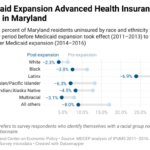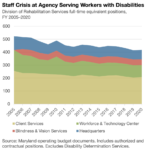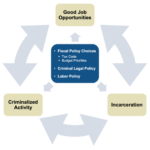Budgeting For Opportunity
How Our Fiscal Policy Choices Can Remove Barriers Facing Marylanders of Color and Advance Shared Prosperity

Maryland’s budget provides the clearest reflection of our priorities as a state. Choices about where we invest our shared resources can help or hinder children’s education, economic security for families and communities, and public health and safety.
These choices about where we invest our shared resources have the potential to advance or to hinder racial and ethnic equity in Maryland. Even choices that appear neutral on the surface can interact with historical and ongoing forms of discrimination to either obstruct or assist Marylanders of color as they seek to contribute to a thriving state. Our fiscal policy choices similarly have the potential to promote or obstruct equity along other dimensions, such as gender, gender identity, wealth, and disability.
MDCEP’s Budgeting for Opportunity series examines the ways our state’s current fiscal policy choices affect Black, Brown, Indigenous and other communities of color, and outlines detailed recommendations for removing barriers and creating a Maryland that truly offers opportunity for everyone.
 Budgeting for Opportunity: Racial Equity Analysis as a Tool to Advance Justice Through Fiscal Policy
Budgeting for Opportunity: Racial Equity Analysis as a Tool to Advance Justice Through Fiscal Policy
Good intentions cannot advance equity on their own. To move Maryland toward a just, prosperous future, policymakers must understand the inequities that characterize the status quo and the historical forces that got us here. They must also have tools for predicting and measuring the impacts of their decisions.
Nowhere is that more important than for fiscal policy. From harmful education cuts following the Great Recession to the major benefits of Medicaid expansion, fiscal policy choices have enormous power to advance or obstruct racial justice. No less important are the tax policy choices that determine how much we can invest in Maryland communities and how much each of us contributes.
As Maryland’s budget process undergoes its most significant reform in 100 years, we should build on this progress by formally incorporating racial equity analysis into our budget process, either as part of the Department of Legislative Services’ agency budget analyses or in a similar venue.
Racial equity analysis is a powerful tool for giving policymakers the information they need to build opportunity for all. It is also essential for informing the public about the consequences of policymakers’ choices. Good intentions cannot advance equity on their own. For these reasons, policymakers should build in racial equity analysis as a standard part of the budget process.
This case study is intended to provide a model of what built-in budget racial equity analysis in state budget processes might look like. Toward this end, the case study assesses disparate impacts of budgetary choices concerning Medicaid-funded home- and community-based services (including expenditures within the Maryland Department of Health Administration and the Medical Care Programs Administration).
This analysis is based on the Race Forward Racial Impact Assessment Tool. This tool centers on the concept of a policy proposal – the purpose of racial equity analysis is to assess the impacts of a proposed course of action.
 Budgeting for Opportunity: Maryland’s Workforce Development Policy Can be a Tool to Remove Barriers and Expand Opportunity
Budgeting for Opportunity: Maryland’s Workforce Development Policy Can be a Tool to Remove Barriers and Expand Opportunity
Every Marylander should have access to a decent job that pays enough to support a family – regardless of their race, ethnicity, gender, or any other aspect of their identity. However, the labor market we have today is far from this ideal. Too many jobs offer paltry wages or lack basic protections, and structural barriers disproportionately keep women, workers of color, and workers with disabilities out of good jobs.
The shared investments we make as a state have the power to move our labor market toward justice and inclusion, or away from it. Nearly every investment the state makes plays a role in supporting a healthy labor market, from public schools to public health and more. Our workforce development system is one investment that focuses specifically on strengthening our labor market, and making wise choices about our investments in workforce development – choices about how much to invest as well as choices about how to run these services – can make our economy more equitable.
Highlights:
- Because of the specific history of racism in Maryland, Black workers often face some of the highest barriers in our labor market. Between 2015 and 2020, Black workers in Maryland were on average slightly more than twice as likely as white workers to be unemployed – meaning they are actively looking for a job but unable to find one – at any given time.
- Our economy has delivered sluggish wage growth to the vast majority of workers over the last several decades, the result of wage suppression policies and corporate efforts to thwart worker organizing. The harm has not been evenly distributed. Black and Latinx workers have experienced slower wage growth during the last decade than their white counterparts, and women’s wages have fallen further behind men’s.
- The state is not investing enough in workforce development services and staff to meet Marylanders’ needs. For example, thousands of Marylanders with disabilities are eligible for workforce services but instead sit on a waiting list because of insufficient funding.
- While our workforce development services are fairly successful in helping workers obtain employment, most participants subsequently take home paltry wages. Women, Black workers, American Indian workers, and workers with disabilities are especially likely to have low post-participation earnings.
- Many participants in our workforce development system face barriers to employment such as lack of access to transportation, inability to afford childcare, or discrimination due to past incarceration – barriers that in many cases are the result of broader public underinvestment. However, most participants do not receive supportive services that could remove these barriers.
Budgeting for Opportunity: Our Shared Investments Can Build Safe, Just, Thriving Communities
It is more critical than ever that Maryland undertake serious review of its spending on incarceration and other parts of the criminal legal system. Our latest report outlines how changing our approach to the state’s criminal legal system would open new opportunities to build stronger communities.
Key findings:
- Maryland’s reliance on incarceration is heavily lopsided. Black Marylanders are 4.5 times more likely to be incarcerated in state prison than those Marylanders belonging to other racial and ethnic groups. American Indian/Alaska Native Marylanders are more than twice as likely as other Marylanders to be in state prison.
- Mass incarceration is incompatible with maintaining good public health amid a deadly pandemic. At least 13 people incarcerated in Maryland and two staff have died of COVID-19 so far, with nearly 1,800 others contracting the virus. The only way to meaningfully protect incarcerated Marylanders from premature death is to rapidly reduce prison and jail populations and provide the supports necessary for returning citizens to transition safely back into the community.
- Strong evidence links a healthy economy—one in which good, family-supporting jobs are available and realistically accessible—to safe communities.
In the first report in this series, we looked at three foundational areas of the state budget: education, health care, and transportation. Targeted investments in these three areas that are essential to building broadly shared prosperity.
- Health: Promoting a healthy population can lead to lower health care costs and fewer work hours lost to illness, while chronic health problems can get in the way of people reaching their full potential. Due to barriers to accessing health care and conditions in their communities, Marylanders of color are more likely to face health problems like low birth weight and asthma, and are more likely to die at younger ages. Making sure everyone can see a doctor without worrying that it will put them deep in debt and tackling environmental hazards like lead can help us build healthier, more prosperous communities for all.
- Education: Education is one of the foundations of long-term economic growth and opportunity, and Marylanders pride ourselves on having great public schools. Yet over the last decade, we have scaled back our investment in schools. This retreat has hit children of color the hardest. We should update our school funding formula, leave ill-advised cuts in the past, and bring all our school buildings into the 21st century.
- Transportation: In order to get and maintain a good-paying job, you need to be able to get there. As a result of policymakers’ past transportation and housing policy choices, Black workers lose more hours each year to long commutes than white workers. To open up opportunities to these workers, we should invest in reliable transit and remove barriers like high auto insurance costs and license suspension policies.


